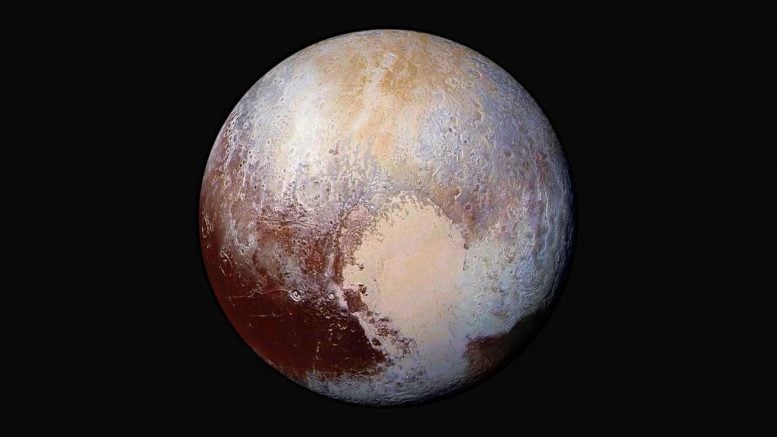
This enhanced color image of the dwarf planet helps scientists detect differences in the composition and texture of Pluto’s surface. Credit: NASA/JHUAPL/SwRI
New research hints that Pluto may still be geologically active, a theory that could explain how Pluto’s escaping atmosphere remains flush with nitrogen.
The latest data from NASA’s New Horizons spacecraft reveal diverse features on Pluto’s surface and an atmosphere dominated by nitrogen gas. However, Pluto’s small mass allows hundreds of tons of atmospheric nitrogen to escape into space each hour.
So where does all this nitrogen come from? Dr. Kelsi Singer, a postdoctoral researcher at Southwest Research Institute, and her mentor Dr. Alan Stern, SwRI associate vice president and the science lead for the New Horizons mission, outlined likely sources in a paper titled, “On the Provenance of Pluto’s Nitrogen.” The Astrophysical Journal Letters accepted the paper for publication on July 15, just a day after the spacecraft’s closest encounter with the icy dwarf planet (ApJ, 808, L50).
“More nitrogen has to come from somewhere to resupply both the nitrogen ice that is moving around Pluto’s surface in seasonal cycles, and the nitrogen that is escaping off the top of the atmosphere as the result of heating by ultraviolet light from the Sun,” said Singer. They looked at a number of different ways that nitrogen might be resupplied.
Singer and Stern wondered if comets could deliver enough nitrogen to Pluto’s surface to resupply what is escaping its atmosphere. They also looked at whether craters made by the comets hitting the surface could excavate enough nitrogen – but that would require a very deep layer of nitrogen ice at the surface, which is not proven. The team also studied whether craters could expose more surface area, by punching through surface deposits that would likely be built up over time.
“We found that all of these effects, which are the major ones from cratering, do not seem to supply enough nitrogen to supply the escaping atmosphere over time,” continued Singer. “While it’s possible that the escape rate was not as high in the past as it is now, we think geologic activity is helping out by bringing nitrogen up from Pluto’s interior.”
And while the data weren’t in before this paper was written, the newest images of Pluto show land forms that suggest heat is rising beneath the surface, with troughs of dark matter either collecting, or bubbling up, between flat segments of crust, which could be related.
“Our pre-flyby prediction, made when we submitted the paper, is that it’s most likely that Pluto is actively resupplying nitrogen from its interior to its surface, possibly meaning the presence of ongoing geysers or cryovolcanism,” said Stern. “As data from New Horizons comes in, we will be very interested to see if this proves true.”
Reference: “On the Provenance of Pluto’s Nitrogen (N2)” by Kelsi N. Singer and S. Alan Stern, 3 August 2015, The Astrophysical Journal Letters.
DOI: 10.1088/2041-8205/808/2/L50
New Horizons is part of NASA’s New Frontiers Program, managed by the agency’s Marshall Space Flight Center in Huntsville, Alabama. The Johns Hopkins University Applied Physics Laboratory in Laurel, Md., designed, built, and operates the New Horizons spacecraft and manages the mission for NASA’s Science Mission Directorate. SwRI leads the science mission, payload operations, and encounter science planning.









The paper states, and I quote: “Given the also demonstrated difficulty of delivering enough N2 with comets, we suggest that either atmospheric escape rates have been overestimated or cryovolcanism or another tectonic or geodynamic means of N2 resupply may be necessary to resupply Pluto’s atmosphere against escape and the buildup of an involatile lag deposit resulting from the escape process. ”
Pluto receives only small amounts of energy via. EM radiation, it receives negligable energy from tidal heating, and if it’s age is to be believed, it’s core and internals are likely to have frozen billions of years ago, yet our top scientists state their is likely an internal ocean of water below the crust allowing upwelling of volatiles through the frozen exterior. This would need active volcanoes and techtonic rifts to currently be supplying the flow, of which there is scant evidence from observations right now, and a new planetary radioactive decay model to explain the internal latent heat.
Without the energy supply of tidal heating from a host gas giant & internal radioactive decay heat source, the only method by which enough energy budget can be supplied to Pluto to produce the observed rate of N2 escape is through the sun / pluto interaction via. charged particles in the solar wind and IMF & pluto’s plasmasphere.
As pluto’s geological features seem to be dichotomous & irregular in location, it would suggest this ongoing process is not only external but also highly variable, much like the solar wind and pluto’s sweeping eccentric orbit. Pluto lacks an internal magnetic field strong enough to protect it from this incoming charge stream and so is more vulnerable to changes in the heliospheric and interstellar environment, this could help explain ongoing and previous more intense geological & atmospheric activity required to explain our observations.
The only reason more serious studies of these effects are not being considered is the process of geomagnetic and electric interaction between star/planet and planet/moon pairs is poorly understood. Pluto just happened to offer the biggest clues as it lies in the most extreme parts of the solar systems environment, it’s time scientists started to make the science fit the observations rather than the other way round.